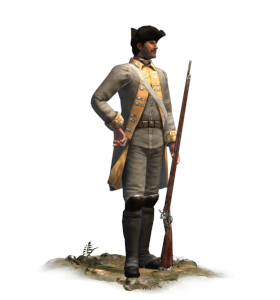Line Infantry (ETW unit)
| Requires | |
|---|---|
| Building (minimum level) | |
| Barracks | |
| Military Governor's Barracks |
These musket-armed troops use massed volleys to break an enemy, relying on discipline to withstand any counter fire.
“Marching regiments” or “line battalions” make up the majority of units in European-style armies. They are so called because they form the line of battle, not because they always deploy in lines. Indeed, over time the capabilities of line infantry should improve as new tactics, drill and weaponry are developed.
These soldiers carry muzzle-loading, smoothbore muskets firing lead balls as wide as a man’s thumb. These are inaccurate weapons, effective only over 200 paces or so and when fired in massed volleys. The ability to fire and reload with machine-like regularity with shot and bullet flying and comrades falling all around is what wins battles.
Historically, in many armies colonels received a fee to raise regiments, which remained their personal property and commands. They jealously guarded their rights to appoint friends, relatives and hangers-on as regimental officers. This contractor system, however, allowed unscrupulous officers to make handsome profits by pocketing the pay of non-existent soldiers. The better colonels did take a pride in their regiments, spending their own fortunes on good uniforms and weapons. The capabilities of a “standard” line infantry unit therefore varied between nations and over time. It wasn’t until the 1760s that anything approaching uniformity of drill, equipment and regulations became the norm.
Line infantry regiments remained unchanged throughout the period, and their organisational pattern still forms the basis of modern military units.
Abilities
- Can guard
- Can hide in woodland
- Grappling hooks
- Resistant to morale shocks
Technological abilities
- Plug bayonet
- Chevaux de frise
- Earthworks
- Fire and advance
- Fire by rank
- Square formation
Available for:
 |
 |
 |
 |
 |
 |
 |
 |
 |

|
| |
|
|
|
|
|
|
|
|
|


